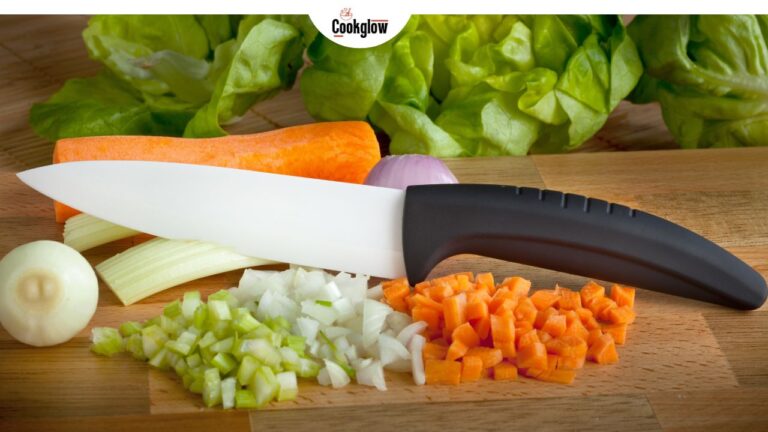
If you’ve ever struggled with a dull kitchen knife or found your steel blade rusting over time, you’re not alone. I’ve been there too—sawing through tomatoes instead of slicing cleanly and wondering if there’s a better solution. That’s when I discovered ceramic knives, and let me tell you, they’re a game-changer!
Ceramic knives are growing in popularity, especially among home cooks and kitchen enthusiasts. What are the advantages of a ceramic knife? They’re lightweight, incredibly sharp, and resistant to rust—making them a fantastic alternative to traditional steel knives. But are they right for everyone? In this guide, I’ll walk you through the key advantages of ceramic knives, how they compare to steel knives, and everything you need to know before adding one to your kitchen.
Let’s dive in!
Contents
What Are Ceramic Knives Made Of?
Ceramic knives aren’t your typical kitchen knives. Unlike steel knives, which are made from metal alloys, ceramic knives are crafted from zirconium dioxide (zirconia), an ultra-hard material that’s second only to diamonds in hardness. These blades are manufactured through a process called dry pressing and sintering, where zirconia powder is compressed under extreme pressure and then baked at high temperatures. This process creates a razor-sharp, lightweight, and highly durable blade.
How Do They Differ from Steel Knives?
At first glance, ceramic and steel knives may look similar, but their differences go far beyond appearance.
| Feature | Ceramic Knives | Steel Knives |
| Material | Zirconium dioxide (zirconia) | Stainless steel or carbon steel |
| Sharpness | Extremely sharp, stays sharp longer | Needs regular sharpening |
| Weight | Lightweight, easy to handle | Heavier, varies by type |
| Rust Resistance | 100% rust-proof | Can rust if not maintained |
| Reactivity | Non-reactive (won’t affect food taste) | Can react with acidic foods |
| Fragility | Brittle, can chip or break | More durable, can bend instead of breaking |
The biggest takeaway? Ceramic knives offer incredible sharpness and rust resistance, but they require careful handling since they can chip or break if dropped.
Key Advantages of Ceramic Knives
Now that you know what ceramic knives are made of, let’s talk about why they’re such a great addition to any kitchen.
1. Sharpness & Edge Retention
If there’s one thing I love about ceramic knives, it’s how incredibly sharp they are. Thanks to the hardness of zirconia, these blades can achieve a razor-thin edge that stays sharp for months, even years, without frequent sharpening.
- Unlike steel knives, which dull quickly and need constant honing, ceramic knives retain their sharpness 10 times longer.
- They’re perfect for precise slicing, making them ideal for tasks like cutting tomatoes, peeling fruits, or slicing boneless meats.
2. Lightweight Design
Ever felt your wrist getting tired after chopping a bunch of veggies? Ceramic knives solve that problem.
- They are significantly lighter than steel knives, making them easy to maneuver and reducing hand fatigue.
- This is especially helpful for home cooks who spend a lot of time prepping ingredients.
3. Rust & Corrosion Resistance
One of the best things about ceramic knives? They don’t rust—ever.
- Because they contain no metal, they are 100% resistant to rust and corrosion.
- This makes them perfect for humid environments or kitchens where knives are frequently washed.
4. Non-Reactive with Food
Have you ever noticed that some knives leave a metallic taste on certain foods, especially acidic ingredients like citrus or tomatoes? Ceramic knives don’t do that.
- Since they are non-reactive, they won’t alter the taste, smell, or color of your food.
- This makes them perfect for fresh fruits, vegetables, and delicate ingredients.
5. Ideal for Fruits, Vegetables & Boneless Meat
Ceramic knives excel in slicing fruits, vegetables, and boneless meats with precision.
- They glide effortlessly through delicate ingredients without crushing or bruising them.
- This is why many professional chefs and home cooks prefer ceramic knives for specific tasks like preparing salads or sushi.

Comparisons: Ceramic Knives vs. Steel Knives
Choosing between a ceramic knife and a steel knife depends on your cooking needs. While both have their advantages, they also differ significantly in terms of sharpness, durability, maintenance, and weight. Here’s how they stack up against each other:
1. Sharpness: Edge Retention & Cutting Ability
Ceramic knives are known for their razor-sharp edges and exceptional edge retention.
- Ceramic blades stay sharp up to 10 times longer than traditional steel knives.
- They glide through soft foods like tomatoes and boneless meats with precision, ensuring clean cuts.
- Steel knives, however, dull faster and require frequent honing and sharpening to maintain performance.
2. Durability: Lifespan & Resistance to Wear
While ceramic knives excel in sharpness, they are more brittle than steel knives.
- Ceramic blades can chip or break if dropped or used improperly.
- Steel knives are more impact-resistant and can handle tougher tasks like cutting through bone or frozen foods.
- A well-maintained ceramic knife can last for years, but steel knives have greater overall longevity due to their durability.
3. Maintenance: Cleaning & Sharpening Needs
Ceramic knives are low maintenance, but they require special sharpening tools.
- Unlike steel knives, ceramic blades don’t rust and are easy to clean with warm water and mild soap.
- Steel knives, especially carbon steel, require regular oiling and drying to prevent rust.
- Sharpening ceramic knives requires diamond-coated sharpening tools, while steel knives can be sharpened with a standard whetstone or honing rod.
4. Weight: Lightweight vs. Heavyweight Usage Benefits
Ceramic knives are significantly lighter than steel knives, making them easier to handle.
- Their lightweight design reduces hand fatigue, making them perfect for delicate slicing tasks.
- Steel knives offer better balance and control, especially for tasks that require more force.
Comparison: Ceramic Knives vs. Steel Knives
| Feature | Ceramic Knives | Steel Knives |
| Sharpness | Stays sharp longer, precise cutting | Needs frequent sharpening |
| Durability | Brittle, can chip or break | Stronger, handles tough cutting tasks |
| Maintenance | Easy to clean, requires special sharpening tools | Needs regular honing & rust prevention |
| Weight | Lightweight, reduces hand fatigue | Heavier, provides better control |
Limitations & Precautions of Ceramic Knives
While ceramic knives have many advantages, they’re not for every task. Here are some key limitations to keep in mind:
1. Brittle Nature & Risk of Chipping
- Ceramic knives are extremely hard, but that makes them more brittle.
- Dropping them or applying too much force can cause chipping or breakage.
2. Not Suitable for Hard Ingredients
Ceramic knives aren’t designed for cutting hard foods like:
- Frozen meats
- Bones
- Hard-skinned vegetables like squash or pumpkins
Using a ceramic knife on these ingredients can damage the blade.
3. Special Sharpening Tools Required
Unlike steel knives, which can be sharpened with a regular whetstone, ceramic knives require diamond-coated sharpening tools.
- This makes sharpening more challenging and costly.
- If a ceramic knife chips, it may need professional sharpening or replacement.

Best Practices for Using & Maintaining Ceramic Knives
To get the most out of your ceramic knife and extend its lifespan, follow these best practices:
1. Proper Storage Methods
- Store ceramic knives in a knife block, sheath, or on a magnetic strip to prevent chipping.
- Avoid tossing them into a drawer where they can get damaged by other utensils.
2. Safe Cutting Techniques
- Always use a wooden or plastic cutting board—hard surfaces like glass or marble can cause the blade to chip.
- Use gentle, straight cuts rather than twisting or prying, which can stress the blade.
3. Recommended Cleaning Methods
- Hand wash ceramic knives with warm water and mild dish soap.
- Avoid dishwashers, as the movement can cause them to knock against other utensils and chip.
By following these maintenance tips, you can keep your ceramic knife sharp, clean, and in top shape for years to come.
Who Should Use a Ceramic Knife?
A ceramic knife is ideal for:
- Home cooks who want a lightweight, easy-to-maintain knife for everyday slicing.
- Vegetarians and plant-based eaters who frequently chop fruits and vegetables.
- Those who dislike sharpening and want a knife that stays sharp for long periods.
When to Choose a Ceramic Knife Over a Steel Knife
A ceramic knife is the better choice if you:
✔ Need a super sharp, precision-cutting tool for delicate foods.
✔ Want a lightweight knife that’s easy to handle and reduces hand fatigue.
✔ Prefer a rust-proof, low-maintenance option for everyday use.
However, if you often cut bones, frozen foods, or tough ingredients, a steel knife will be the better option.
Final Thoughts
Ceramic knives are a fantastic complement to traditional steel knives. They aren’t a complete replacement, but they shine in specific tasks where precision and sharpness matter most. If you want a light, ultra-sharp knife that requires minimal upkeep, a ceramic knife is definitely worth adding to your kitchen toolkit.

